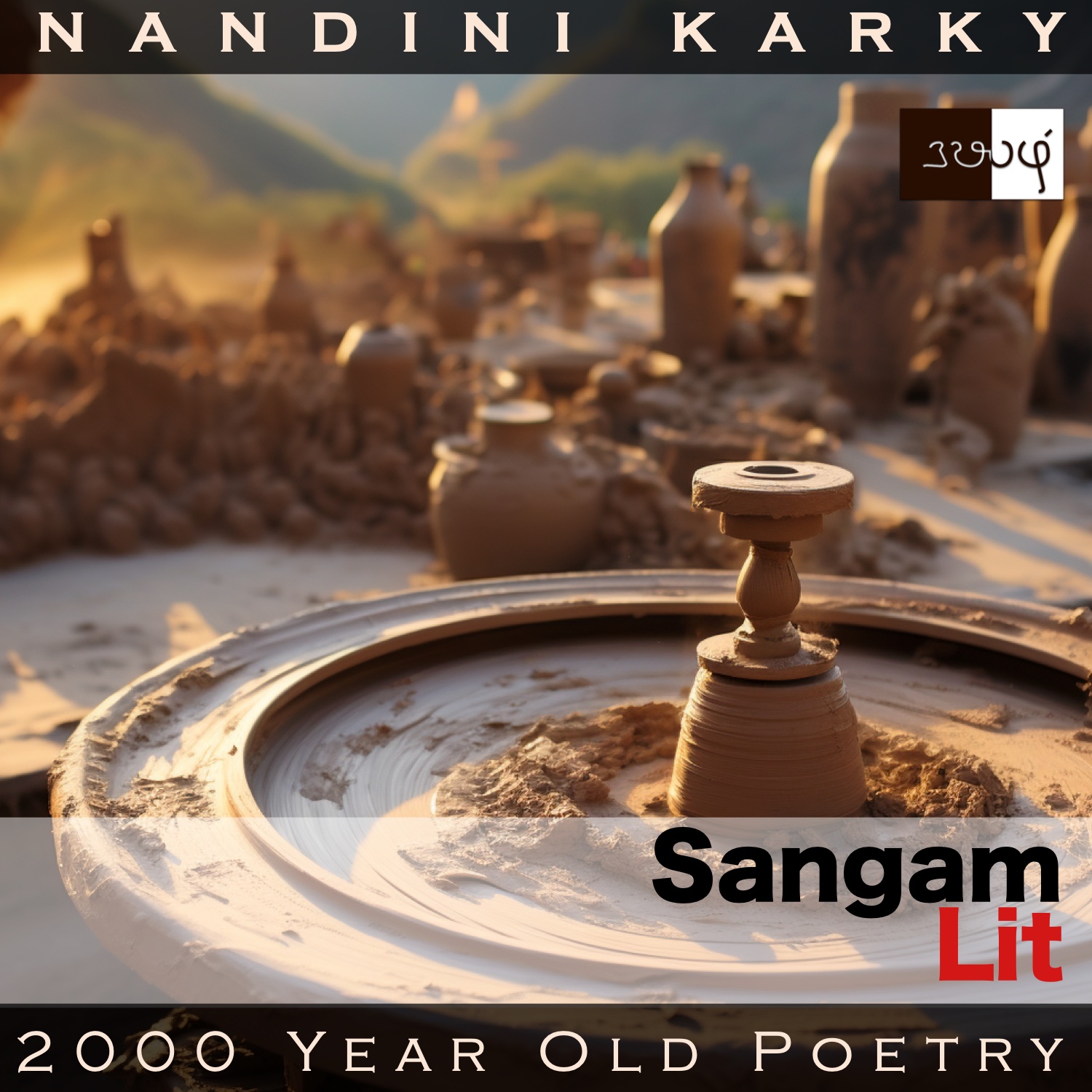Podcast: Play in new window | Download
Subscribe: Apple Podcasts | Spotify | Amazon Music | Android | iHeartRadio | Email | TuneIn | RSS | More
In this episode, we perceive a poet’s conversation with a potter, as depicted in Sangam Literary work, Puranaanooru 228, penned about the Chozha King Kulamuttrathu Thunjiya Killivalavan by the poet Aiyoor Mudavanaar. Set in the category of ‘Pothuviyal Thinai’ or ‘Common Themes’, the verse provides literary evidence about burial customs in the Sangam era.

கலம் செய் கோவே! கலம் செய் கோவே!
இருள் திணிந்தன்ன குரூஉத் திரள் பரூஉப் புகை
அகல் இரு விசும்பின் ஊன்றும் சூளை,
நனந் தலை மூதூர்க் கலம் செய் கோவே!
அளியை நீயே; யாங்கு ஆகுவைகொல்?
நிலவரை சூட்டிய நீள் நெடுந் தானைப்
புலவர் புகழ்ந்த பொய்யா நல் இசை,
விரி கதிர் ஞாயிறு விசும்பு இவர்ந்தன்ன
சேண் விளங்கு சிறப்பின், செம்பியர் மருகன்
கொடி நுடங்கு யானை நெடுமா வளவன்
தேவர் உலகம் எய்தினன்ஆதலின்,
அன்னோற் கவிக்கும் கண் அகன் தாழி
வனைதல் வேட்டனைஆயின், எனையதூஉம்
இரு நிலம் திகிரியா, பெரு மலை
மண்ணா, வனைதல் ஒல்லுமோ, நினக்கே?
An insightful and imaginative song conveying the greatness of this much-celebrated Chozha king. The poet’s words can be translated as follows:
“O master maker of pots! O master maker of pots! With a hue, akin to darkness stuffed in a spot, spreads thick smoke towards the wide and dark sky from the kiln in the wide-spread, ancient town, O master potter! You are to be pitied! For what can you do?
Adorning the spreading land, stood his huge and mighty army. He had the great fame of being sung by poets many. Akin to the spreading rays of the sun upon the sky, spreads far the greatness of the Sembiyan scion, possessor of elephants with fluttering flags, the great Valavan. As he has reached the heavenly world, you desire to carve a wide urn to enclose him. You are to be pitied for how is it possible for you to make a pot with a wheel as wide as this world and an entire tall mountain as your base clay?”
Let’s dig deep to reveal the treasures in this verse. The poet starts by addressing a much-respected professional in the Sangam era – a potter! He mentions how the smoke from the kiln where the pots are being heated soars up to the sky in that ancient town. It always thrills me to see the word ‘Moothoor’ or ‘ancient town’ in a Sangam verse because this is a record of Sangam people telling us that the town had been in existence for a long time prior to theirs, and are thus, serving as a bridge between us, their descendants, two thousand years later, and their ancestors in the distant past. Returning, we find the poet pitying the potter and saying there was nothing the potter could do, just then.
When we ask the poet what he means, without directly answering us, he starts talking about the great fame of this king, who possessed a huge army and was sung about by numerous poets, and illustrates the way the king’s fame spreads like the rays of the sun upon the sky. Now, the poet turns back to the potter and remarks how the potter intends to make an urn to enshroud the king, because the heir of the Chozhas, King Valavan, had parted away to the next world. Seeing the urn as an object meant to contain not the mortal form of this king but his eternal fame, the poet declares the only way to make the urn perform that task was to make it with a mound of clay as high as a mountain on a potter’s wheel as wide as this world, and he concludes, as this is an impossible task, the potter is to be pitied indeed!
Even as the poem reveals the poet’s skills of imagination in conjuring a wheel as huge as the earth and a heap of clay like a mountain to make a pot to hold this king, the professional who captures the spotlight however is the potter! This song transported me to the Keezhadi museum I had visited a few months ago, and made me relive the awe I felt in the presence of those magnificent creations in clay – the red and black pots and the huge burial urns.




These urns, which are the symbols of death, ironically bring alive the past lives of the ancients. Be it any civilisation, the artefacts that greatly inform the field of archaeology are burial urns and the goods they hold within. Now, with the added scientific developments in the field of ancient DNA, these remains of ancient people are turning out to be the most promising ticket to time travel to the past! And so, here we have an ancient verse, featuring a poet’s view and a potter’s work, perform the magic trick of merging the streams of literature, history, archaeology and ancient DNA in a sea of meaning!




Share your thoughts...